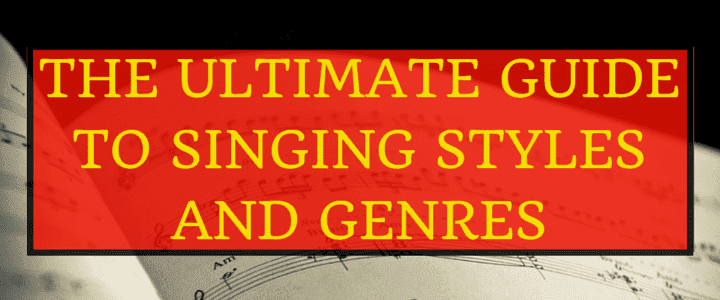If you are looking for vocal warm-up exercises that match the song you’re trying to sing perfectly, you’ll want to read this article.
The vocal exercises for a singer, after all, will be different depending on what kind of music he wants to sign – and if he has specific needs. There are some vocal cord dysfunction exercises, in fact, that can be extremely helpful for someone with those needs, regardless of the musical genre.
The best way to find out what kind of vocal exercises are best for you? Take singing lessons!
There are so many different types of singing styles and genres out there. Throughout the centuries, the many different cultures around the world came up with their own scales and modes, and different types of music emerged.
These styles, or genres of music, are just as diverse and varied as the cultures themselves. Each genre has its own special characteristics that make it different from others, and each genre presents unique challenges for singers.
Here’s a list of the most common genres of music, tips for singing each one, and some well-known examples you might recognize.
What Are the 5 Vocal Techniques?
Regardless of the genre, there are five core vocal techniques you should master, either through daily singing practice or through the specific vocal exercises we will tell you about in this post. The big 5 include:
- The Full Belt – often considered a cornerstone technique for pop singing (think Whitney Houston!)
- Breathy Singing – using aspirated tones in music, typically in the quieter moments of the song
- Mixed Belt – this is a bit more concentrated in the chest than the full belt
- Voice Break – many singers try to avoid the voice break but it’s a technique that’s often used purposefully in many songs
- Head Voice – this technique can add variety to a song
These aren’t the only vocal techniques that you can phone with practice and vocal function exercises. However, they are some of the most common. Ultimately, your goal when practicing these vocal techniques should help you add beauty, tone, musicality, and meaning to the songs you sing.
Here is a video that has some great tips on how you can practice these techniques and incorporate them into your daily singing routine:
Why Do You Need to Do Vocal Exercises?
Just like you would warm up before any other rigorous workout, you need to warm up before you start to sing. Doing vocal exercises for singers is an essential part of a good practice and performance routine. It will allow you to sing better, extend your range, and prevent overuse injuries.
Some great warm-ups include things like:
- The yawn-sigh technique
- Humming
- Jaw loosening exercises
- Tongue trilling
- Vocal sirens
- Lip buzzes
Don’t forget to warm up the other muscles that are necessary for singing in addition to your vocal cords. Do a few quick shoulder rolls, give yourself a face massage, or do some deep breathing to help your entire body get ready for singing.
Again, singing lessons from a professional singer will help you figure out the best kind of warm-ups to do.
The 7 Most Common Types of Singing and Vocal Exercises
There are many different singing styles, types, and genres out there. It takes a different set of skills to sing in each one. However, you’ll find many commonalities between the most common types – and you can improve your ability to sing any kind of song by performing vocal exercises on a regular basis.
Below, we’ll walk you through the most common types of singing as well as some of the best vocal exercises for beginners in these genres.
Pop
If music is food, then pop is candy. It’s fun and romantic, but not overly sentimental. With dance and rhythm at its heart, pop music has dominated a lot of American music over the past 30 or so years, and many singers have come and gone.
But several pop singers have come to be considered the greatest entertainers of all time, including Whitney Houston, Madonna, Prince, and the “King of Pop,” Michael Jackson.
Tips & Vocal Exercises for Pop Singers
- Learn how to control your vibrato without tension.
- Experiment with different vocal sounds, like short, popping sounds and fast runs.
- Focus on improving your movement on stage and take dance lessons, if necessary.
Famous Pop Singers
Tori Kelly
Tori chose a really high key for this song. She also chose to accentuate the lyrics of the song with a short, light texture in her voice. That kind of texture makes everything easier to sing in your high register.
Whitney Houston
At 2:05 in this video, Whitney uses a fast run on the end of the word “all.” Notice how she doesn’t make it overly dramatic, and uses those runs only a few times in the song? Sometimes, too many runs can be distracting from the song’s message.
Bruno Mars
Bruno sings tenderly because it’s a tender song. His voice is so free of tension that he seems to float up into his falsetto.
Rock
You might be surprised to learn that rock is a grandchild of the blues. After it became heavier and more dance-ably rhythmic, the music began to “rock” – and rock and roll was born!
It grew up to become rougher and edgier, and now, rock vocal sounds are as diverse as in any other genre. Today, rock singers include voices as different as Adam Lambert, Tom Araya of Slayer, James Hetfield of Metallica, and Bono of U2.
But that rougher and edgier part of rock has to be, at least in some ways, a defining characteristic of the rock voice. Otherwise, it might be confused with an adult contemporary or pop voice.
Tips & Vocal Exercises for Rock Singers
- Try out different vocal flairs, like a little growling or vocal fry at the end of song sections, but don’t overdo it.
- Get comfortable singing a huge range of dynamics, from whispers (used sparingly for the health of your voice) to healthy, supported shouting.
- Don’t be afraid of your own vibrato.
Famous Rock Singers
Freddie Mercury
Freddie Mercury was known for quite a theatrical kind of rock. Notice how easily he transitions from one dynamic to another, using subtlety when it’s needed for effect, and rough growling when the lyrics call for it, like at 2:20.
John Fogerty
John Fogerty of Creedence Clearwater Revival sings this song with the emotional sense of defiance. He clearly has a hold of being what we now call a “singing actor,” though it’s doubtful that the vocals were planned as such.
Ann Wilson
The lead singer of Heart, paying tribute to Led Zeppelin, keeps a true sense of her own voice but doesn’t change the vocals so much that it’s disrespectful to the original. She’s clearly not afraid of her own vibrato, using it as a tool to accentuate certain lyrics, like at 4:24.
Bonus Quiz: What Genre Are You Destined to Sing?
Opera and Classical
Often considered the most formal and restrictive of all genres of singing, classical and opera singing actually require the greatest amount of freedom. Much of it is sung with uncontrolled vibrato and total emotional release.
It is, however, the least conversational of all genres. Because it lacks the intimacy of that conversational quality with the audience (think folk music), it has the tendency to give audiences the impression of admiring a beautiful painting from afar.
The classical genre includes secular arias and religious oratorios, as well as motets. Opera singing is similar, but it’s part of a stage production, often involving dancing and speaking parts. Think of opera as a musical with classical singing instead of Broadway-style singing.
Tips & Vocal Exercises for Opera Singers
- Don’t try to sound how you think an opera singer sounds. Sing with an open and free voice.
- Vibrato sometimes develops over time as we let go of more and more tension. Don’t force it or try to create it.
- Get a voice teacher. Soon. Opera singing can seldom be taught without a good teacher.
Famous Opera and Classical Singers
Bryn Terfel
In this incredibly dramatic scene from Mozart’s interpretation of the Don Juan story, Bryn Terfel is the actor in the reddish-brown cloak. Watch how intense and exaggerated his facial expressions are throughout the scene.
Kiri Te Kanawa
Singing one of the best-loved arias ever written, here is one of the best-loved sopranos to have ever lived. She is an incredible example of how you can sing beautifully through your entire life if you take good care of your voice.
Marian Anderson
Marian Anderson’s distinguished career is marked not only by fantastic singing, but also by courageous defiance in the face of racism. Her voice is flawless, in spite of the shortcomings of the old recordings, but more importantly, her heart can be heard in everything she sings.
In the video above, she sang for a beautiful Christmas program. Notice her alignment and how it remains consistent throughout the changes in the song.
Country
An overly simple way to think of the country genre is fancy folk. But it’s had quite a history through the years, having evolved from Appalachian mountain music, southern blues, country-western and what’s called “honky-tonk.”
I recommending listening to many different country voices so that you don’t get into the trap of imitating only the big voices. Think about how different Carrie Underwood’s voice is from Miranda Lambert’s.
Check out the differences between Hank Williams, Jr. and Luke Bryan. And don’t forget to listen to classic singers like Dolly Parton and Patsy Cline.
Tips & Vocal Exercises for Country Singers
- Don’t force a “country” accent. If you listen to a lot of country music, over time, a natural twang will come when you sing.
- Become familiar with great storytelling; that’s where country comes from! Listen to professional storytellers on YouTube.
- Be willing to wear your heart on your sleeve. Audiences love when country singers share their feelings, and your credibility is based on your ability to be genuine.
Famous Country Singers
George Jones
In one of the most famous country songs of all time, the irreplaceable George Jones exemplifies the all-important skills of storytelling and a down-to-earth singing style. Notice that there isn’t a lot of vibrato here; it’s almost as if Jones is too busy telling a story to hold out a note and show off!
Carrie Underwood
Both this song and video are great examples of country. Carrie, season 4 winner of American Idol, knows just how to use her voice to a song’s advantage. She floats a note (sings it lightly) when it’s a tender moment and then sings with a heavier tone when it’s a heavier moment.
Loretta Lynn
The ultimate story song, “Coal Miner’s Daughter,” was Loretta Lynn’s biggest hit. Take note of how similar her speaking voice (at the beginning of the video) is to her singing voice. This can be achieved through the study of something called “speech level singing.”
Blues and Jazz
The blues were born in the American south from the spirituals of slaves and the call-and-response music of the Southern church. Think of jazz as its slightly more sophisticated child who never forgot its roots.
Jazz singing is characterized by clear, “speech level” singing and distinct consonants, while blues singing has a rough or rootsy edge to it, sometimes with a natural Southern accent.
Tips & Vocal Exercises for Blues Singers
- You can’t sing the blues and jazz right without knowing its history. Watch Ken Burns’ Jazz documentary and the Thelonius Monk documentary, “Straight, No Chaser.”
- Experiment with different vocal sounds, like pitch slides and scatting.
- Study up on your music theory, especially your chromatic scales.
Famous Blues and Jazz Singers
Cassandra Wilson
Though she may not be the best-selling jazz artist, Cassandra Wilson is considered by many to be the best living jazz singer. Her voice is perfect for it — rich, thoughtful, and focused. Notice how around 3:05, she begins to use pitch slides.
Sarah Vaughan
Once described as having “one of the most wondrous voices of the 20th century,” Sarah Vaughan was known for a sensitive but easy tone. At 2:15, she effortlessly shows off an impressive vocal range and some great improvisation skills.
Louis Armstrong
Louis Armstrong is so important to jazz music that most experts agree it wouldn’t have been developed, or even survived, without his contributions. Here we have a great example of a singer who loved what he did and knew how to make people feel happy and entertained.
Hip Hop
Hip hop, the heavily rhythmic and rhyming singing that often accompanies rapping and beat-boxing, emerged in the 1970s, and has grown steadily in popularity since then.
In fact, that popularity has turned into tremendous influence on other singing genres, including pop and country. Its origins are many, but the most apparent are funk, disco, reggae, and the blues. Singers of hip hop are diverse, but the singing generally takes on edgy and sometimes nasal qualities.
Tips & Vocal Exercises for Hip Hop Singers
- Know hip hop’s musical ancestry. Listen to a lot of funk, disco, reggae, soul, gospel, blues, and old-school hip hop.
- You don’t have to become a rapper, but get comfortable switching between singing and speaking lyrics to help your versatility.
- Don’t be afraid to experiment with different vocal sounds, like nasality and wordplay, to create your own signature style.
Famous Hip Hop Singers
Lauryn Hill
See if you can hear the song’s Spanish and gospel influences. Despite these varied sounds, Lauryn stays true to her own voice, which is stunningly consistent in tone and texture. It’s important to listen to influences with respect, without allowing it to pressure you to imitate.
Beyonce
In this heart-stopping acoustic performance of her hit “Halo,” Beyonce has full command of her voice.
It’s as if her voice is an arrow, she aims at the bull’s eye, and hits it every time. In other words, her pitch is always right and her transition between the lower register in the verses and the upper register in the chorus is seamless.
Cee Lo Green
Originally, the hit “Crazy” was created and released by Gnarls Barkley, a musical duo consisting of rapper and hip hop singer Cee Lo Green and producer Danger Mouse.
In this video, Cee Lo sings the song at a much slower tempo than the original, allowing for a lot of time for both the performer and the listener to really think about the meaningful lyrics.
Adult Contemporary
Adult contemporary is such a unique genre, because singers from relatively different genres often get put into this camp as well, or end up here at the height of their career.
It’s essentially pop singing, but the lyrics are decidedly grown-up, or “adult.” Adult contemporary has been called “vanilla,” bland and boring, but often, the most magnificent songs ever are forever embedded in its charts.
Tips & Vocal Exercises for Adult Contemporary Singers
- Learn how to sing consistently with a well-supported sound and power will come naturally.
- Get into the habit of speaking the lyrics of the song out loud before singing them.
- Don’t add too many effects to your voice; singing with whatever you have, in its truest form, is adult contemporary.
Famous Adult Contemporary Singers
Bruce Hornsby
This is a classic example of an adult contemporary theme – the songwriters here are reflecting on their own lives and on life in general. Bruce Hornsby’s easy, almost-nonchalant style comes across as utterly conversational, perfect for singing about down-to-earth themes.
Amy Grant
Amy Grant successfully crossed over from contemporary Christian music (which she practically created herself) to pop and adult contemporary. All the while, she never really changed her vocal sound. Throughout this video, she uses dynamics to her advantage to highlight certain words.
How Do You Strengthen Your Vocal Cords? Best Vocal Function Exercises To Try
Regardless of whether you use your vocal cords to make a living – like you might as a professional singer – or not, it’s important to exercise your vocal cords to keep them in tip-top shape.
There are all kinds of exercises you can do, including:
- Larynx breathing exercises
- Diaphragmatic breathing
- Vocal cord dysfunction breathing exercises
- Soft palate exercises
- Tongue exercises
Follow these tips to keep your voice healthy – and avoid bad habits – to keep your vocal cords healthy for the long-term.
Do Vocal Exercises Really Work?
Without a doubt, doing vocal exercises is one of the best ways to keep your voice healthy, strong, and above all, beautiful. They really do work!
Of course, that’s not all! There are so many different styles of music to discover, as well as sub-genres within each category. For a comprehensive list of musical genres, AllMusic is a great resource. We also love this interactive genre map from Every Noise at Once.
So there you have it, the ultimate guide to singing styles! If you have additional questions, check in with your singing teacher for help finding your unique voice. Happy singing!
 About the Author: Heather L. teaches singing and more in St. Augustine, FL. She is a graduate of Westminster Choir College in Princeton, New Jersey, and has performed with the New York and Royal Philharmonics, the New Jersey, and Virginia Symphonies. Learn more about Heather here!
About the Author: Heather L. teaches singing and more in St. Augustine, FL. She is a graduate of Westminster Choir College in Princeton, New Jersey, and has performed with the New York and Royal Philharmonics, the New Jersey, and Virginia Symphonies. Learn more about Heather here!Suzy S.

